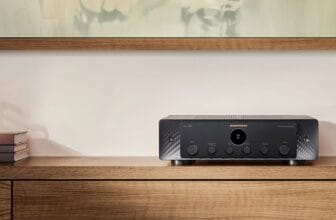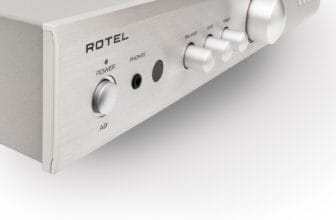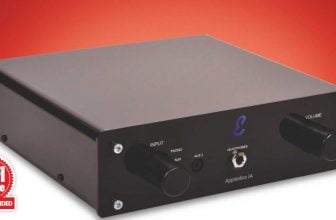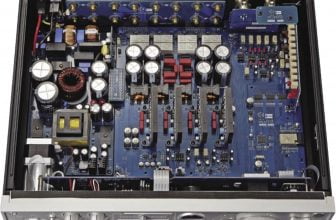LONGDOG AUDIO P6100M Review
Monoblock power amplifiers from specialist LongDog Audio capture Noel Keywood’s attention. Read our LONGDOG AUDIO P6100M Review.
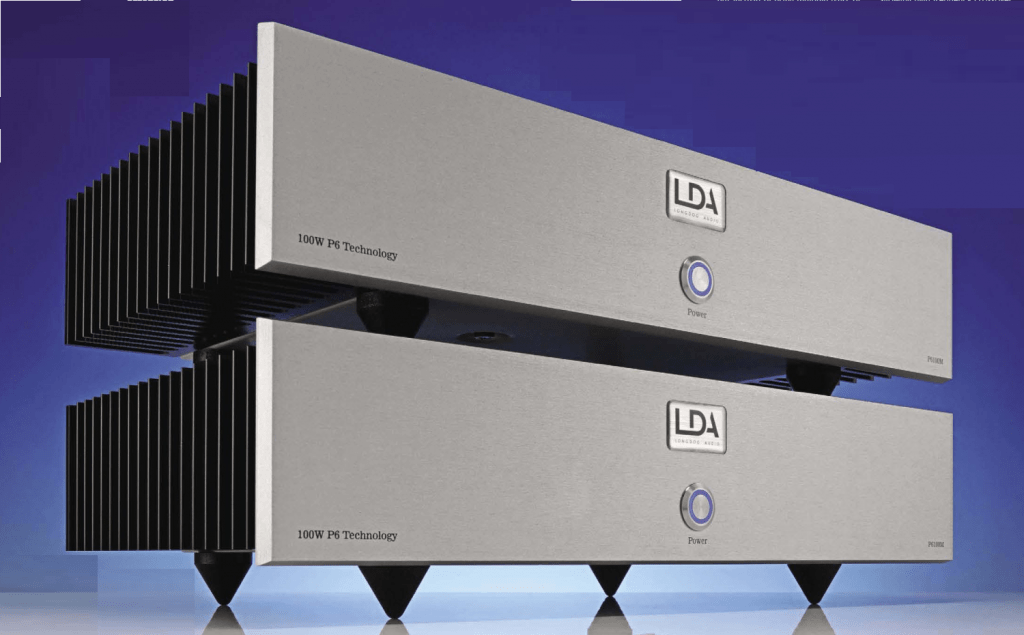
Here’s a specialist 100 Watt power amplifier that isn’t specialist. It’s an audiophile design that uses latest developments in transistors but is right down the line in electronic engineering terms, even in front – that’s why it measured so well and sounded so good. There’s a price to pay – £ per pair – but it’s not possible to say the Longdog Audio LDA P6100M monoblock power amplifiers cannot justify that.
What Longdog’s Nick Gorham says about the P6100M is that it follows conventional design practice but instead of using multiple pairs of low power output transistors in loadsharing arrangement, it uses single devices that do a better job. These transistors are high power MOSFETs from Ixys, linearised to be suitable for audio. And that’s unusual. High power MOSFET transistors are common in heavy switching circuits to control big electric motors and suchlike, but not in audio because they produce too much distortion.
Since heavy power switching is a larger market than audio, there’s little commercial incentive to produce a high power MOSFET with what is termed a ‘linear transfer characteristic’. But as the production technology of such devices has progressed Ixys have come up with suitable devices – first used by Longdog Audio in their P6 power amplifiers we reviewed in the April 2018 issue. The new P6100Ms produce similar power but in a much smaller case and at half the price.
MOSFETs are wide bandwidth transistors, so when feedback is applied as much is available at high frequencies as low frequencies, allowing high frequency crossover distortion to be suppressed. That’s why MOSFETs are popular in audio use; distortion can be virtually eliminated, albeit by use of heavy feedback.
But using multiple devices introduces matching and thermal tracking problems. All such matters are dealt with internally in the particular Ixys MOSFETs within the P6100M, Longdog say. So there are only two devices per amplifier, one to push, the other to pull.
I have spoken to Nick Gorham many times at The Bristol Show where he enthusiastically heads up the Longdog stand and know he is not only a knowledgeable electronics engineer but also an audiophile able to understand the subtleties of amplifier behaviour that affect sound quality, plus the skill to make subjective assessments of sound quality – as you have to in real life with audio equipment. It isn’t all about theory and measurement. Explaining the fact that these power amplifiers are not just heavy sloggers able to deliver high volume, they are audiophile designs using appropriate components and design techniques.
A useful 100 Watts is available, plenty enough for most situations, but case size is kept within acceptable domestic proportions of 430mm wide, 260mm deep and 110m high, and weight an easily handled 8.5kg. Since a 19in standard rack is 482mm wide, they will fit, but only one per shelf. The cases are non-magnetic aluminium to avoid hysteresis distortion being induced by magnetic fields. The output stages run in Class A at low output and the heatsinks get gently warm, so Class A on normal running but Class A/B on musical peaks, as per usual. But the MOSFETs used are linear over a broad power range so there was no change in distortion pattern from low to high power, measurement showed.
The rear panel carries balanced XLR inputs and unbalanced phono socket inputs, a small toggle switch choosing between them. Input sensitivity is a standard nominal 1V into both, making any preamplifier suitable. The internal power supply is a conventional linear design (not switch-mode) with toroidal mains transformer. There are protection circuits and long-stop slow-blow fuses.
What’s missing? You get only one pair of loudspeaker terminals so bi-wiring is awkward, and there is no headphone output, no remote control and no volume control.
SOUND QUALITY
I connected the P6100Ms to our Martin Logan ESL-X hybrid electrostatic loudspeakers through Chord Company Signature Reference cables. They were fed from the balanced outputs of our Oppo UDP-205D universal player from its internal ESS ES9038PRO DAC, for a clean source, using Chord Company Epic XLR terminated cables. Hi-res was fed in, via optical connection (QED Quartz), from an Astell&Kern AK120 portable
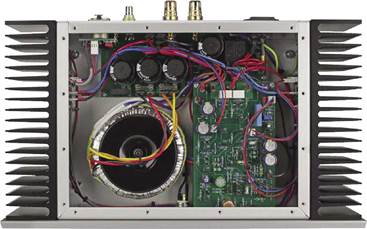
player run from its battery to avoid ground noise.
With the Pink Panther Theme (uncompressed CD) the saxophone was well fleshed out and crisp in outline. Fine cymbal taps were made obvious and I got the sense of strong inner detailing. A dry, controlled sound, rather than big and warm, but very nimble.
With Loreena McKennitt’s The Gates Of Istanbul, the introductory bass line was held in vice-like grip, coming across as strong but not overblown. The P6100Ms are not warm in balance, so much as crisp and vivid. The pounding bass synth in Safri Duo’s Samb Adagio rocketed from the ‘speakers, with no overhang or waffle: the word “grip” came to mind.
When I spoke to Nick Gorham about these amps and his design philosophy, he told me that a subtle difficulty he tries to minimise is that of memory effects in devices and I have to say that the sheer bass speed and resolution of high frequency detail – the spacing between transients – was a stand out feature our ESL- X electrostatics made plain. So with these amps think clear and forward upper mid-band, an open and detailed sound, not glassy or hard but strongly etched all the same. Cuddly – no. Vivid – yes.
Time for LP I thought – to introduce some analogue warmth. For this the amps were fed direct from our Icon Audio PS3 Mk2 valve phono stage (which has a volume control), via Chord Company Epic phono interconnects. Turntable was our Timestep Evo Technics SL-1210 Mk2 Direct Drive with SME309 arm and Audio Technica VM750 SH (Shibata) moving magnet cartridge. A totally silent system with no sign of hum or hiss, and the P6100Ms were completely silent at switch on and off.
Spinning Dire Straits ‘So Far Away’ on Mobile Fidelity’s 45rpm cut of ‘Love Over Gold’ again brought out the incisive speed of these wideband amplifiers. I could hear every fine intonation within Mark Knopfer’s vocals and the drum rolls raced along. His guitar cut out strongly. My notes say “incredibly fast and tight”; the warmth of this LP was exchanged for precision.
CONCLUSION
The Longdog Audio LDA P6100M monoblock power amplifiers are speedy in their sound and highly analytic. With enormous insight and massive grip they certainly impress. I found them very easy to set up and use, with absolutely no foibles: just press and play. You then get to hear it all. They lack warmth, making them best suited to fulsome loudspeakers, but their superb grip and insight more than make up for this, to those that want to hear it all.

MEASURED PERFORMANCE
The Longdog Audio LDA P6100M power amplifier produced 100 Watts into 8 Ohms and 156 Watts into 4 Ohms – enough power to go very loud.
Output impedance measured 0.1
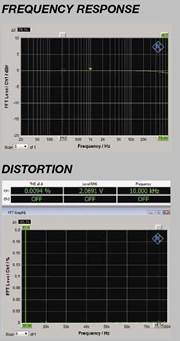
Ohm, giving a high Damping Factor of 80.
Distortion measured 0.006% in the midband and 0.01% at 10kHz at 1 Watt output; there was no crossover distortion. At high power (-1dB below full output) the figure dropped slightly to 0.004% across the audio band, due to relatively lower noise at high output. Distortion harmonics were barely in existence.
Via the balanced XLR analogue input frequency response measured flat from 3Hz to 120kHz (-1dB), so this is a very wideband amplifier. Wideband amps lack warmth but sound ‘faster’ and apparently more detailed. The unbalanced phonosocket input gave identical results.
An exemplary set of results from a wideband amplifier. NK
Power 100W
Frequency response (-1dB)
3Hz-120kHz Distortion (10kHz, 1W) 0.01%
Separation (1kHz) 96dB
Noise (IEC A) -103dB
Sensitivity 1.1V
Damping factor 80
LONGDOG AUDIO P6100M
EXCELLENT – extremely capable.
VERDICT
MCRU
+44 (0)1422 250590
www.mcru.co.uk


